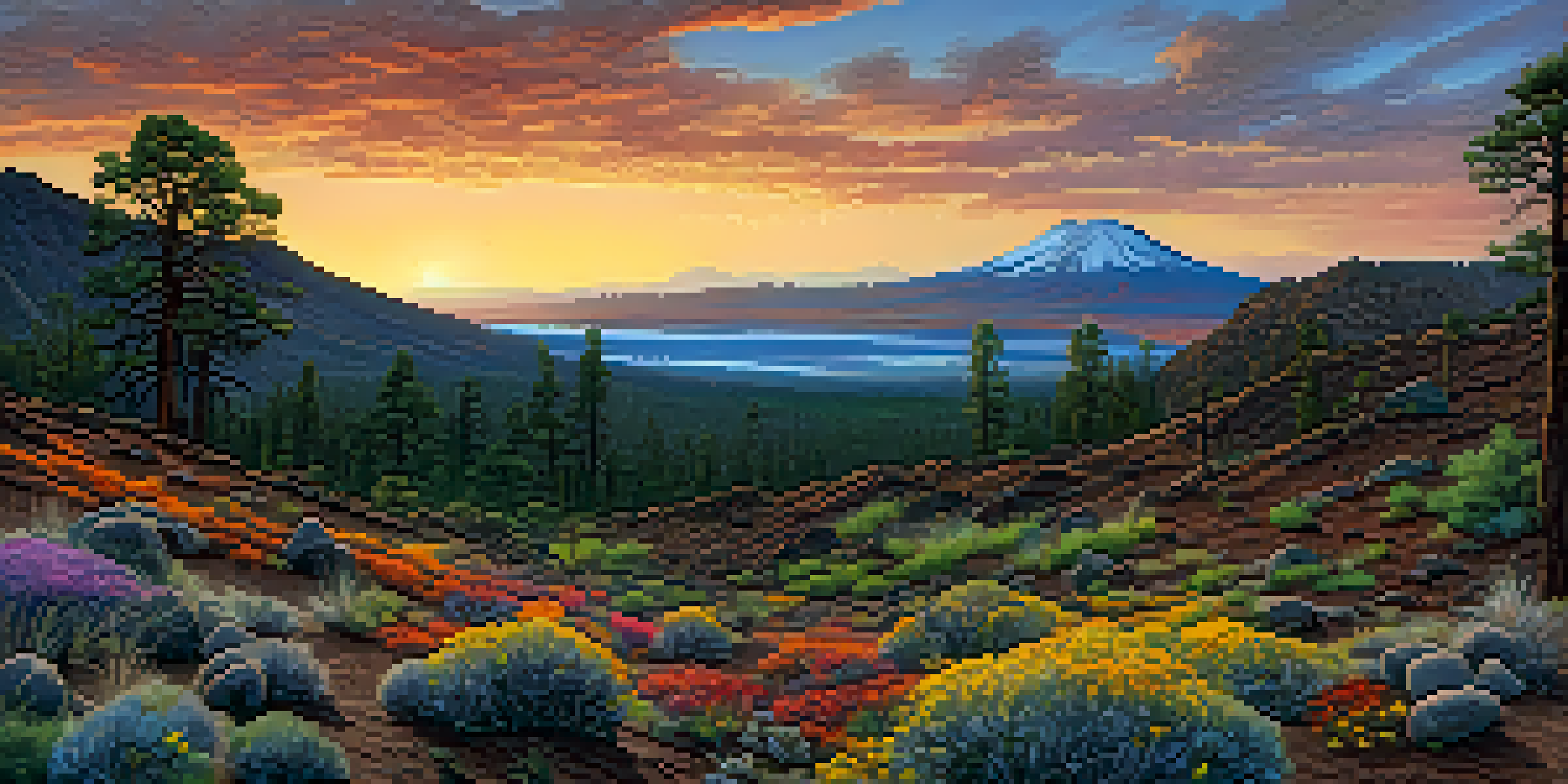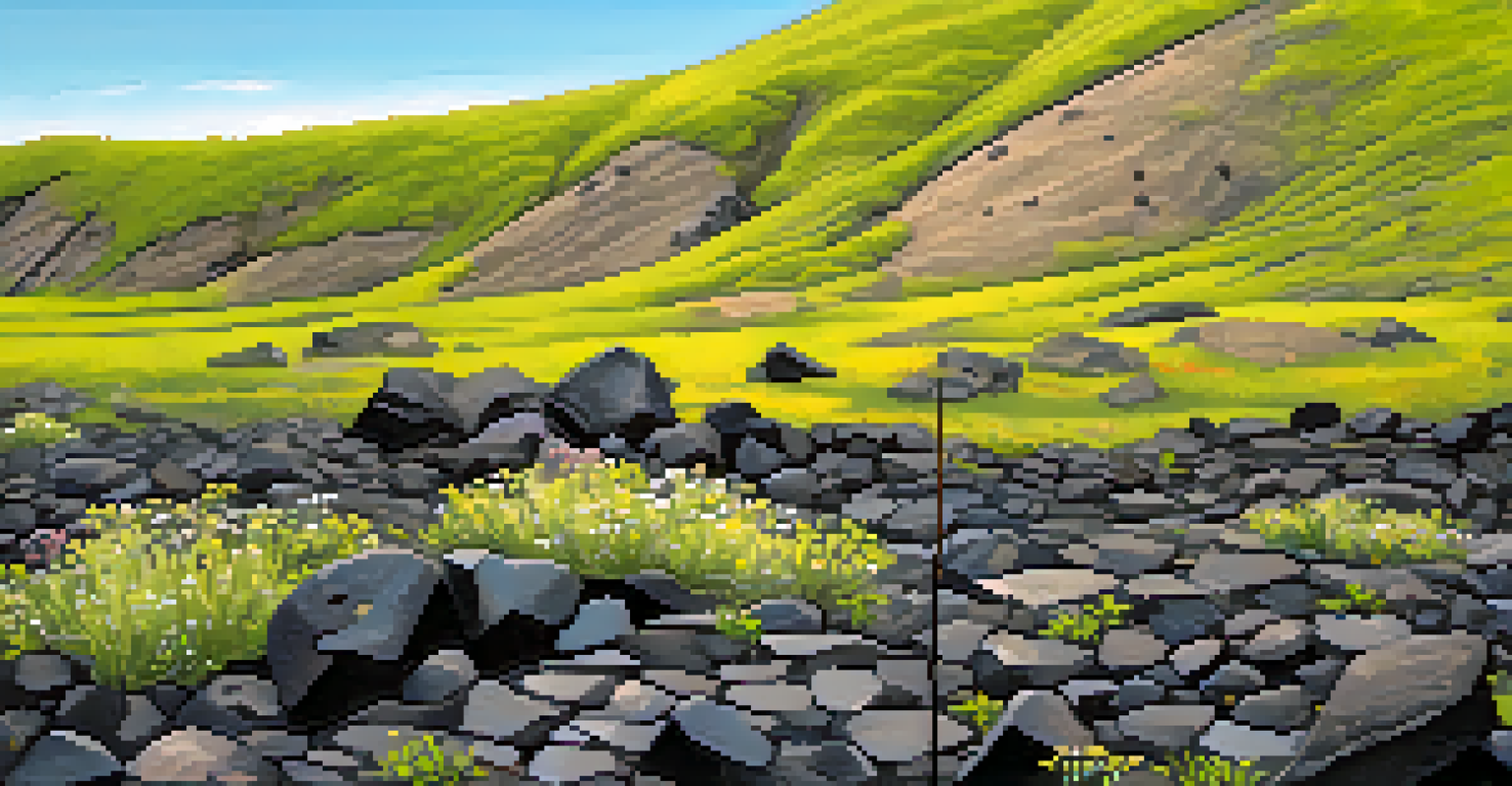Volcanic Activity and Its Impact on Arizona's Landscape

Introduction to Arizona's Volcanic History
Arizona's landscape is a stunning tapestry of geological features, and volcanic activity has played a significant role in shaping it. From the iconic Sunset Crater to the expansive San Francisco Peaks, these formations tell a story of fire and transformation. Understanding this volcanic history helps us appreciate the beauty and complexity of Arizona's terrain.
The earth has music for those who listen.
The state's volcanic activity dates back millions of years, with evidence of eruptions still visible today. These events not only shaped the physical landscape but also influenced the ecosystems and human settlements that followed. By exploring this history, we can gain insight into how nature's forces have sculpted the land we see today.
Through this article, we will delve into the various aspects of volcanic activity in Arizona, examining its causes, effects, and lasting legacy. Join us on this journey through time as we uncover the impact of volcanoes on Arizona's unique geographical identity.
How Volcanic Eruptions Shape the Landscape
Volcanic eruptions can dramatically alter the landscape, and Arizona is no exception. When a volcano erupts, it spews lava, ash, and gases that can create new landforms and reshape existing ones. For instance, the formation of cinder cones and lava flows around Flagstaff offers a vivid example of how explosive activity can leave lasting impressions on the earth.

These eruptions can also lead to the creation of unique geological features, such as calderas and volcanic craters. The remnants of these explosive pasts not only serve as fascinating sites for study but also as popular destinations for hikers and tourists. The interplay of natural elements like fire, water, and wind continues to shape these volcanic landscapes.
Arizona's Volcanic Legacy
The volcanic history of Arizona has shaped its unique landscape, influencing ecosystems and human settlements.
In addition to physical changes, volcanic eruptions can influence the local climate and environment. The ash and gases released during eruptions can affect air quality, soil fertility, and even weather patterns, showcasing the far-reaching effects of these natural events.
Key Volcanic Sites in Arizona
Arizona is home to several notable volcanic sites that attract visitors and researchers alike. One of the most famous is Sunset Crater, which erupted about 1,000 years ago and is now a national monument. Its distinctive dark lava flows and colorful cinder cones provide a glimpse into the region's volcanic past, making it a prime spot for exploration.
Nature does not hurry, yet everything is accomplished.
Another significant site is the San Francisco Peaks, which feature the highest point in Arizona at Humphreys Peak. This volcanic mountain range is not only a geological wonder but also a critical watershed for the area. The stunning views and diverse ecosystems found here highlight the relationship between volcanic activity and natural beauty.
Lastly, the volcanic field around Flagstaff offers a wealth of cinder cones and lava tubes, perfect for adventure seekers. Each site provides a unique opportunity to learn about the processes that shaped Arizona's landscape while enjoying the great outdoors.
The Ecological Impact of Volcanic Activity
Volcanic activity in Arizona has profound ecological impacts that extend beyond the immediate area. After an eruption, the landscape undergoes a process of regeneration, with new plant life emerging from the nutrient-rich soil created by volcanic ash. This rejuvenation is vital for local ecosystems, providing habitats for various species.
Furthermore, the unique conditions created by volcanic structures can lead to distinct microclimates. These microclimates support diverse plant and animal life that may not thrive in other parts of the state. For example, the cooler temperatures at higher elevations in the San Francisco Peaks create an environment for species typically found in much different climates.
Cultural Ties to Volcanoes
Indigenous peoples in Arizona regard volcanic sites as sacred, reflecting deep spiritual connections to the land.
However, it's essential to recognize that volcanic activity can also pose challenges to local ecosystems. Eruptions can destroy habitats and lead to ashfall that affects air and water quality, illustrating the complex balance between creation and destruction in nature.
Cultural Significance of Volcanoes in Arizona
Volcanoes in Arizona hold significant cultural importance, particularly for Indigenous peoples. Many tribes view these geological features as sacred, intertwined with their history, spirituality, and identity. For example, the Hopi and Navajo tribes have deep connections to the land shaped by volcanic activity, viewing it as a source of life and tradition.
The stories and legends surrounding these volcanic sites are rich and diverse, reflecting the deep respect these communities have for nature. By understanding these cultural narratives, we can appreciate the profound impact of volcanic landscapes on human life and history.
Moreover, as visitors explore these sites, it's crucial to acknowledge and respect the cultural heritage tied to them. Promoting awareness of this significance helps foster a deeper connection between people and the land, enriching the experience of exploring Arizona's volcanic landscapes.
Volcanic Activity and Tourism in Arizona
Arizona's unique volcanic features have made it a hotspot for tourism, attracting nature enthusiasts, hikers, and geology buffs. Sites like Sunset Crater and the San Francisco Peaks draw thousands of visitors each year, eager to witness the remnants of ancient eruptions. This influx of tourism provides economic benefits to local communities and encourages conservation efforts.
Local businesses thrive on the tourism generated by these natural attractions, with amenities ranging from guided tours to outdoor gear rentals. The popularity of these sites also paves the way for educational programs that raise awareness about volcanic activity and its impact on the landscape.
Tourism and Conservation Balance
The state's volcanic features attract tourists, providing economic benefits while highlighting the need for sustainable practices.
However, tourism comes with responsibilities. It's vital to promote sustainable practices that protect these delicate environments while allowing people to enjoy and learn from them. Striking a balance between tourism and preservation ensures that future generations can experience the wonders of Arizona's volcanic landscapes.
Future of Volcanic Activity in Arizona
As we look to the future, understanding volcanic activity in Arizona remains crucial for both scientific inquiry and public safety. Researchers continue to monitor the state for signs of seismic activity, as dormant volcanoes can potentially awaken. Staying informed about these geological processes helps communities prepare for any future events that may arise.
The study of past eruptions also provides valuable insights into the potential risks associated with volcanic activity. By analyzing historical data, scientists can better predict how and when future eruptions might occur, helping mitigate hazards for residents and visitors alike.

Ultimately, the future of Arizona's volcanic landscapes depends on our commitment to understanding and preserving them. As we deepen our knowledge, we can ensure that these natural wonders continue to inspire awe and curiosity for generations to come.